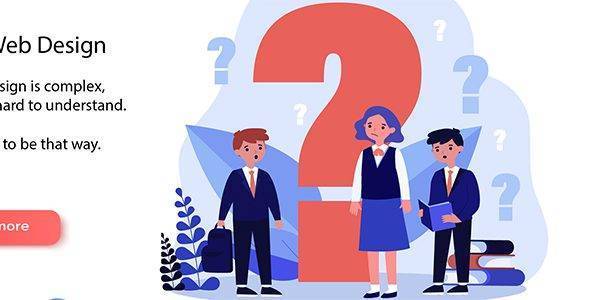Is traditional web design broken?

Filters
Results
For anyone who has experienced the website design process, they’ll know it’s quite the journey. Sometimes it feels like you’re hiking up a mountain or even travelling to a different country – sometimes in a rowboat! You need a budget, resources, time, and you have to make all kinds of preparations for this journey to be successful.
If you have been in this situation, think back to previous website design projects you’ve been involved in. What went well? What didn’t go well? Which emotions did you experience during those redesigns?
A recent survey to more than 100 marketers and business owners, suggested there are a lot of different emotions they experienced during a website redesign. There are some positive emotions: excitement, hope, pride. But the majority of responses were negative: frustration, stress, and overwhelmed. And even… holiday. These people are thinking, “I want sun and sand and anything to get me out of here…” Kidding aside… But it is kind of true. Traditional web design is complex, complicated, and hard to understand. But does it have to be that way?
The traditional web design process is broken, and that can make it frustrating
Let’s think about what has to be done each time you embark on a website design or redesign journey in the traditional way.
Before you get started
First, you need a team of experts that can join or lead you along the way. The assembled team may consist of people from your own company too, but ultimately you’ll need some outsourced marketing experts like a web design or marketing agency and/or web developers.
Next, you need a budget. You may not even know what this should be if you’ve never done this before, or you may have an idea of what you would like to spend. The average website for a small- to medium-sized business can cost between $5000 to $30,000 or even $80,000, and even more for an enterprise business. Yep, it’s a massive ball-park! You can find out more about the costs that go into a website in our article, How much does a website cost?
And just like a trip up Mount Everest or planning your dream holiday, building a decent website is a long journey. On average, it takes three to six months to build a new website. This is true even if you can plan every step of the timeline: when things are delivered, when things need to be approved, and when things are handed off to specific teams. Many times, a website project can go over budget or miss a deadline because there are so many variables.
Problems with traditional web design
Thinking about all of our previous web design projects: Were they launched on time? Did they stay in scope? Were they on budget? Often, but not always. Things happen and obstacles arise. Most web design companies have been approaching web design projects in the same way for the past twenty years. But if you take a step back, there are two systemic problems that shouldn’t be ignored.
First, traditional web design is risky for your business
Why? Because of the large upfront cost, the amount of dedicated time, energy, and resources. Then there’s also the chance the project can still go over budget and beyond its delivery date. After all of that, it’s still unclear how much the website is going to impact the bottom line of the business.
Eventually, the website goes live… And it’s time to rejoice! Finally, this long, grueling project is done and the team can return to all the other things that were set aside during the last six months while building the website. Things can go back to normal. But should they?
Now, on a scale of one to ten, how important is your website to your business? What would happen to the growth of your business if your website disappeared tomorrow? HubSpot found that marketers and business owners overwhelmingly agree that their websites are critical to the growth of their businesses.
But now, the real question…
How often do you make impactful improvements to your website?
“Impactful” is continually improving, optimizing, and building key parts of the site to drive business value. These are updates that bring in business and make things easier for customers. Blog posts and offers are good, but they aren’t necessarily “impactful”. These are changes like adding options to buy online, a reservation calendar, and so on. While all marketers and business owners agree that the website is critical to business growth, 42% make impactful improvements to their website only once or less each year.
Think about that for a second.
Your website is your company’s number one marketing asset
It’s the first place people go to get information and get a first impression of your business. It’s also your company’s number one salesperson, working 24 hours a day, seven days a week, to nurture people through the sales process. Instead of being neglected for years with minimal updates, shouldn’t this important asset get the resources and attention it needs to continue being a top performer?
If a website is like a team member, it too needs new goals to strive for. A staff member who never progresses and has the same skills 1 year in as they did on Day 1 is often seen as mediocre. Without updating or improving the website, it’s not performing as well as it could be. And like employees, your website might need some updated goals to strive for!
The second problem with traditional web design is that it produces poor results
There are lots of obstacles that arise during the traditional web design process. And then once it’s complete, it may not get updates to do better. It’s not uncommon to see websites that aren’t updated for months or even years–when they could be producing better results.
In considering these two conclusions–that traditional web design is one, risky, and two, produces poor results–it’s easy to see that the traditional web design process is broken. It’s not due to a lack of talent. Often there are talented people involved in a web project. It’s not due to a lack of budget, either. Even in projects that have an unlimited budget, these problems still arise.
These problems happen because of a broken playbook. The traditional way of doing web design is the problem.
As a business, the traditional web design model can leave you extremely vulnerable to project failure and often does not produce optimal results. So what are you supposed to do if this is always the way web design companies have built websites? Does this make you wonder What should you expect from a web design company?
There is a better way, and it’s called Growth-Driven Design
Growth-Driven Design is a smarter approach to web design that reduces the frustration and risk of traditional web design. Growth-Driven Design drives optimal results by learning about your visitors through data and continually improving the performance of the site. And Growth-Driven Design improves the entire company by sharing user learnings with other departments and helps users achieve their goals by using the website.
So what is growth-driven design?
Growth-driven design is a long-term website design strategy done through three main stages: Strategy, Launchpad, and Continuous Improvement. The long-term goals for the website are planned upfront, then a simple, workable website is built and launched and is continuously updated and refined. We go over the growth-driven design strategy in-depth in our article How Growth-Driven Website Design Works. Give it a read or if you’re keen to talk about how to update or improve your website now, get in touch with us and come in for a chat.





